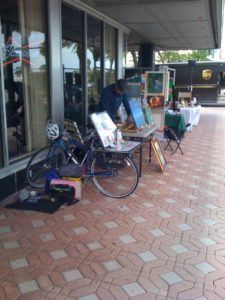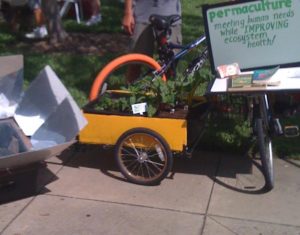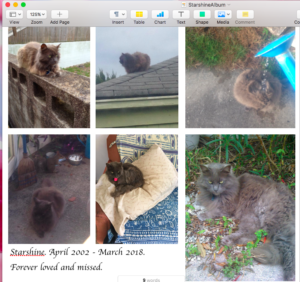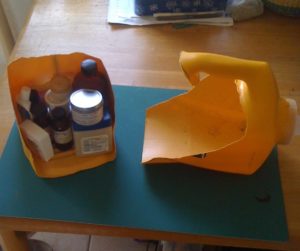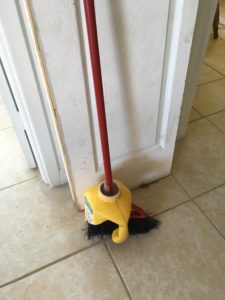In a recent post I mentioned that the refrigerator is the largest consumer of electricity in my house. Since I don’t use air-conditioning, heat, water-heater, or a clothes dryer, or any electronics other than phone and laptop and occasionally a tiny speaker, the fridge accounts for probably 80 percent of my electricity use.
One summer some years back, while I was living in an RV in Austin, Texas, I experimented with going fridgeless. I blogged about it in the Austin EcoNetwork newsletter, and am pasting the text of that article here for you. I wrote this back in 2011.
*******
One of the eco-focused online communities I belong to is the 90PercentReduction Yahoo Group. Participants are dedicated to reducing their personal eco-footprints to 10% of the U.S. average. In this challenge, which for most of us is really more of an ongoing adventure than a state of arrival, we employ various simple yardsticks. And (in what one list member dubbed “Mister Wizard Science Experiments”), we tweak our daily living habits on a trial-and-error basis, each one of us serving as our own lab rats.
The other day, one list member announced her decision to experiment with going without a refrigerator in June. Other list members, who either live fridge-free full time or have conducted short-term experiments in doing so, chimed in with helpful suggestions.
Tried-and-true strategies include reducing or eliminating perishable foods from one’s diet; digging a root cellar; and using the grocery store as your “external cold storage drive.” Of course, not all of these strategies will work in every climate or living environment. For example, if you don’t have a grocery store in walkable or bikable distance.
Beyond the practical tips for living fridge-free, one list member also pointed out that today’s refrigerators consume relatively little electricity, so doing without a fridge might not be such a meaningful exercise. As a permaculturist, I adhere firmly to the design principle, “Obtain a yield.” Reducing electricity consumption by even a watt here and there is a good thing for the planet, but in order for doing without a fridge to be worthwhile for people, they need to be getting something out of it. Personally, I have obtained significant yields from my Fridgeless experiment. These yields and some of my research findings are summarized below. My Fridgeless experiment (in the summers of 2009-2010 in Austin) gave me many yields including:
• enhanced resilience: I learned how I would cope, and help others cope, if the grid went down;
• the satisfaction of adopting a practice that, were it adopted by enough other people, would significantly reduce demand now being served by coal and nuclear;
• tastier food: Produce that’s been chilled loses much of its flavor;
• good skills of organization and food management.
What I learned:
• If I don’t use a fridge in summer, I need a really good varmint-proof box such as a sturdy cooler etc. Well, in this climate, hardly anything is varmint-PROOF, but varmint-resistant is essential.
• One function of a fridge is air circulation. Veggies in a box without air circulation don’t keep as long. If I had stayed in that RV, I would have turned the space formerly occupied by the fridge into a screened food-storage box that would be designed to draw cool air upward. (This would optimally be located on the north side of the house, which mine was.)
• The giant mutant cockroaches of Texas LOVE grapefruit. As in, will gnaw holes in the peel to get to the juicy fruit. I found this out the hard way so you don’t have to. [shudder]
• Sauerkraut that takes a week to make in winter, can be ready in a couple days in summer.
• In a hot climate, pickles are very helpful, just as spices are, for digestion and appetite.
• Being able to walk to a grocery store is a lifesaver. Their fridge becomes my “external storage drive,” so to speak. (Note: Of course, that externalizes part of my footprint, but there would be some net energy savings thanks to economies of scale.)
• Feral foods such as nopalito, lambs quarters, etc, that grow all over wherever you live, are also a lifesaver.
• And of course you can always be growing a bit of your own. Even if you’re a pathetic brown-thumbed gardener like me, you can always be growing SOMETHING. For me, that “something” is most often sprouts in a jar!!!
• Present-day Americans refrigerate a lot of stuff that doesn’t need refrigerating. (Actually I knew this before.)
• Sometimes a listserve post can become a blog entry, that might embolden and inspire others to conduct their own “Mister Wizard Science Experiments” in fridgeless living …
By the way, in my current home in Florida, we have four adults and one teenager sharing a refrigerator. I don’t need the fridge much, but like it because it lets me keep fresh cream for my coffee. And a final note: In winter, even in Austin, I found I didn’t really need a fridge at all, so I just quit using it.
*******
Postscript: Reading this article, and noticing the electricity consumption of the large old fridge in the house where I now live, has rekindled my interest in fridgeless living. The article by Karen Hendry, posting on the Survival Sullivan website (see “Further Reading” links below), has renewed my inspiration also. I may or may not go fridge-free long term, but it sure is liberating to have this means of further reducing my footprint. And to be someone who doesn’t worry much about power outages!
The last few paragraphs of Ms. Hendry’s article sum it up nicely:
Having a fridge is perhaps the epitome of our privileged, gluttonous North American lifestyle. In many countries around the world, people live without the convenience of a fridge and they manage just fine. Will you have to adjust your lifestyle to accommodate a lack of refrigeration? You bet!
There won’t be a cold drink waiting for you after you finish work, but you’ll get used to that. You will also only be able to cook smaller meals that won’t result in leftovers, but you will be eating fresher food, smaller portions, and less junk (like ice cream). This means you will be living a healthier lifestyle and be more motivated to reduce the amount of food you waste.
Hey, you can always try it for a month and see what you think. Your fridge will always be there if you decide you can’t live without it.
Further Reading:
• Excellent article by “Survival Sullivan” on how to live without a fridge. The site is prepper/doomer-oriented, and although I don’t prefer to maintain that kind of mindset day in and day out, Survival Sullivan offers a wealth of practical advice for anyone looking to cut their footprint while also “planning for the worst.” My preferred strategy of planning for the worst is to build resilience (as opposed to, say, hoarding massive stores of packaged food and other supplies). Learning how to live without a fridge (even if you prefer to use a fridge in your everyday life) is a prime example of building resilience. SSullivan’s article is very detailed and extensive; even has a segment about making homemade bacon!
• To my surprise, after retrieving the file of my article “The Fridgeless Experiment” from my hard drive, I actually found my article still up on Austin EcoNetwork’s website!
By the way, AEN’s website is another good one to bookmark. There’s a critical mass of eco-expertise that’s well-reflected in the various blogs on the site. I also find the Jobs section inspiring, and the news of new local businesses such as a snow-cone business . Glimpsing the rich social/economic/business ecosystem of another city, particularly one like Austin that’s had a lot of success in “greening up,” can expand our awareness and help us raise the bar for what’s possible in our own hometowns. Think bicycle-based composting businesses, and a shaved-ice food truck called SolarSno, which is powered entirely by off-grid solar energy.

